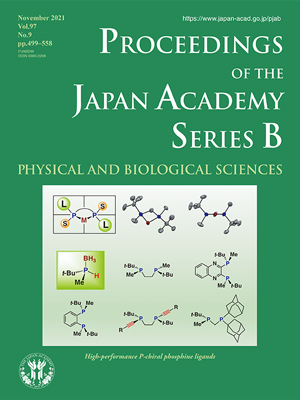About the Cover
Vol. 97 No. 9 (2021)
High-performance P-chiral phosphine ligands
Chirality is a key factor in the molecular interactions of the living systems. As proteins and enzymes are composed of l-amino acids, their chiral receptors are also chiral and capable of recognizing the difference between right- or left-handed molecules. As such, in designing molecules for pharmaceuticals, agrochemicals, and fragrances, the chirality of the molecules that interact with chiral receptors should be considered.
Traditionally, optical resolution had been used for the preparation of enantiomerically pure compounds; whereas, currently, an emerging, powerful alternative, catalytic asymmetric synthesis is used. Owing to the groundbreaking progress during the last four decades, some transition metal-catalyzed processes, including the asymmetric hydrogenation of prochiral olefins, have reached a level of high efficiency and practicality, having applications in the laboratories, as well as the large-scale production of useful chemicals.
For the transition metal-catalysts to conform a platform for the enantioselection, a judicious choice of the center metal and chiral ligand is essential. Various precious metals, such as Pd, Rh, and Ru, have been employed in the former context, while chiral phosphines have played considerable roles for the latter. Although numerous phosphine derivatives have appeared, further sophistication in the ligand design was needed to actualize ideal catalysts with total efficiency in the terms of the reactivity, enantioselectivity, turnover number/frequency, and broader applicability.
Dr. Tsuneo Imamoto, an author of the present issue (pp. 520–542), has long led this research area. He focused on the P-chiral phosphine ligands with stereogenic phosphorus atoms, which were previously inaccessible. He developed an original synthetic protocol using a unique molecular class, phosphine–borane, allowing access to the P-chiral phosphine ligands, showing excellent performance in Rh-catalyzed asymmetric hydrogenations. In addition, he gained a new mechanistic insight distinct from previous theories, that is, a dihydride pathway via a hexacoordinated Rh(III) dihydride complex at the enantio-determining step.
The front cover of this issue illustrates the contributions of Dr. Imamoto. The quadrant diagram (top-left) features his ligand design concept, exploiting the t-butyl group as a bulky group (L) and the methyl group as a small group (S). The figure (highlighted by a green shadow, middle-left) shows a chiral, nonracemic secondary phosphine–borane, which allows access to the P-chiral phosphine ligands. In addition to the simplicity and aesthetic beauty, these ligands are capable of forming rigid metal complexes, as shown in the X-ray structure of the four-membered Rh-complex (top-middle and right). Among others, the ligand with a quinoxaline core (middle-right) is now commercially available and widely used in academia and industries.
Furthermore, this review includes personal accounts of Dr. Imamoto’s spirit as to how he chose the research topics and faced the challenges during work that finally got circumvented. Reading this would provide inspiration and courage to the younger generations.
Keisuke Suzuki
Member of the Japan Academy




